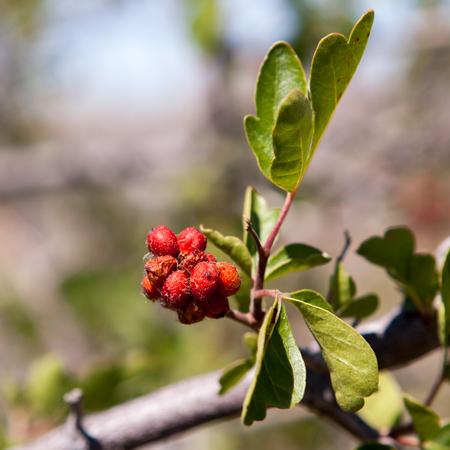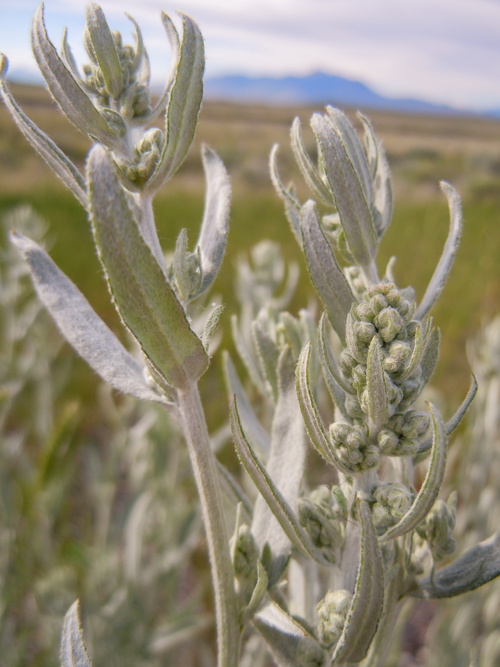At the Cheyenne River, the captains meet fur trader Jean Vallé who tells them about that river. The ash tree leaves are turning color, and Clark finds that buffaberries make a delightful tart. Lewis describes sharp-tailed grouse feet and adds dwarf sagebrush, white sage, and aromatic sumac to his plant collection.
The Trader Jean Vallé
by Yellowstone Public Radio[1]Originally aired weekdays by Yellowstone Public Radio during the Bicentennial observance of 2003-2006. Narrated by Hal Hansen. Scripts by Whit Hansen and Ed Jacobson. Produced by Leni Holliman. © … Continue reading
Aromatic Sumac
Rhus aromatica (Rhus trilobata Nutt.)
© 23 July 2013 by Kristopher K. Townsend. Permission to use granted under the Creative Commons Attribution-Share Alike 4.0 International license.
Setting Out
we Set of as usal under a hard Breeze from E. Sailed on verry well past an Island. passed an old village of the Rick Rees [Arikara] nation on S. S. passed the Mouth of a large River on the South Side called ashea or dog River, which is about [blank] yards wide a Great nomber of Sand bars at & near the Mouth (we had Some difficulty to pass)
—John Ordway
Vallé Describes the Cheyenne River
Mr. Vallie informed us he wintered last winter 300 Legus up the Chyemne River under the Black mountains, he Sais the River is rapid and bad to navagate
—William Clark
Indian Intelligence
The Chyenne Nation has about 300 Lodges hunt the Buffalow, Steel horses from the Spanish Settlements, which they doe in 1 month—
—William Clark
Grouse Boots
worthy of remark that the Grouse or Prarie hen [sharp-tailed grouse] is Booted, the Toes of their feet So constructed as to walk on the Snow, and the Tail Short with 2 long Stiff feathers in the middle.
—William Clark
Dwarf Sagebrush Specimen
No. 60 1804 October 1st another variety of wild sage growth of high and bottom prairies
—Meriwether Lewis[2]Artemisia cana, Moulton, ed. Herbarium, specimen 17a.
White Sage Specimen
Artemisia integrifolia? L. Wilde Sage, on the bluffs, Octr: 1, 1804
—Meriwether Lewis[3]Artemisia ludoviciana, Moulton, ed. Herbarium, specimen 21b.
Aromatic Sumac Specimen
No. 57. October 1st 1804 first discovered in the neighborhood of the Kancez River—now very common, the growth of the little cops which appear on the steep declivities of the hills where they are sheltered from the ravages of the fire—
—Meriwether Lewis[4]Rhus aromatica, Moulton, ed. Herbarium, specimen 148.
Weather Diary
Thermot. at rise
Weather Wind at rise
thermotr. at 4 P.M. Weather Wind at 4 oC P.M. 40 cloudy S E. 46 cloudy S E the leaves of the ash popular & most of the shrubs begin to turn yellow and decline came too this evening near the habitation of a Frenchman—
—Meriwether Lewis[5]To assist the reader, the editor of this web page has omitted the “day of the month” column and spelled out some abbreviations.
Notes
| ↑1 | Originally aired weekdays by Yellowstone Public Radio during the Bicentennial observance of 2003-2006. Narrated by Hal Hansen. Scripts by Whit Hansen and Ed Jacobson. Produced by Leni Holliman. © 2003 by Yellowstone Public Radio. |
|---|---|
| ↑2 | Artemisia cana, Moulton, ed. Herbarium, specimen 17a. |
| ↑3 | Artemisia ludoviciana, Moulton, ed. Herbarium, specimen 21b. |
| ↑4 | Rhus aromatica, Moulton, ed. Herbarium, specimen 148. |
| ↑5 | To assist the reader, the editor of this web page has omitted the “day of the month” column and spelled out some abbreviations. |
Experience the Lewis and Clark Trail
The Lewis and Clark Trail Experience—our sister site at lewisandclark.travel—connects the world to people and places on the Lewis and Clark Trail.
Discover More
- The Lewis and Clark Expedition: Day by Day by Gary E. Moulton (University of Nebraska Press, 2018). The story in prose, 14 May 1804–23 September 1806.
- The Lewis and Clark Journals: An American Epic of Discovery (abridged) by Gary E. Moulton (University of Nebraska Press, 2003). Selected journal excerpts, 14 May 1804–23 September 1806.
- The Lewis and Clark Journals. by Gary E. Moulton (University of Nebraska Press, 1983–2001). The complete story in 13 volumes.



